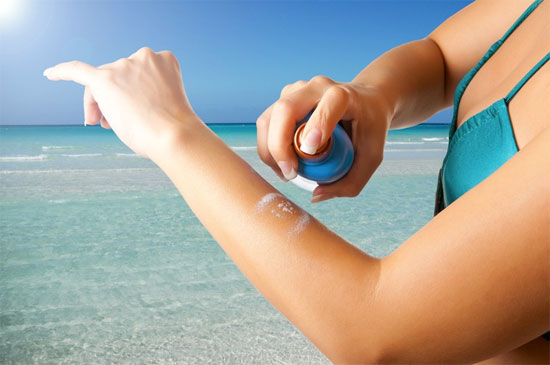Interesting mysteries about sunscreen
Sunscreen is a product familiar to many people, especially women. However, there are still many interesting things that you do not know about sunscreen.
>>>Sunscreen prevents aging skin
1. First sunscreen
In addition to umbrellas and hats for long sunshine, people know how to use many sunscreens extracted from herbs. The first creams made from rice bran oil, iron, clay and asphalt.
Sunscreen was developed strongly in the 1910s, the first product extracted from chestnut, creamy, with the trade name Zeozon.
In the 1940s, US Air Force soldiers used petrolatum veterinary medicine to make sunscreen.
2. How does sunscreen work?
Sunscreen is made of two basic ingredients: inorganic particles such as titanium dioxide, zinc oxide and organic substances extracted from herbs or compounds in the oxybenzone group.
Inorganic particles reflect UV light, organic matter absorbs UV and converts its energy into heat, helping to counteract the chemical reaction on the skin.
Dr. Shannon Trotter from Ohio State University said it would be optimal to use both ingredients. A component against the chemical impact and the remaining component against physical impact. Most sunscreens today contain these two ingredients.

3. Does sunscreen reduce vitamin D?
Many people are afraid of sunscreen that reduces the amount of vitamin D that is synthesized under the influence of sunlight. Researchers have shown that sunscreen does not significantly affect this issue.
The American Academy of Dermatology recommends that people take vitamin D-rich foods such as fish oil, salmon, sardines, soy milk, eggs, and mushrooms to provide vitamin D to the body instead of getting the sun's impact. .
4. Spray sunscreen
Spray sunscreen is convenient to use, but not really safe. The American Pharmaceutical Association advises not to put sunscreen near the fire. When a fire is encountered, the user is prone to burns.
Spray cream usually contains flammable ingredients like alcohol, organic solvents. These are non-healthy and flammable substances.
Dr. Trotter advises that people should only use the spray for body parts that are difficult to use in the form of cream and when used, keep the mouth sprayed close to the skin, limiting the cream to the air.
5. Tips for users
Use sunscreen 15 minutes before going outside and don't forget to put sunscreen on your lips.
The US Centers for Disease Control recommends that people use sunscreen to protect against UV-A, UV-B and contain at least 15% of sunscreen ingredients.
Everyone should check the expiration date, because some ingredients in the cream gradually become ineffective and give rise to bacteria.
People with oily or acne-prone skin should use water-based sunscreen. People who are sensitive to para-aminobenzoic should choose to buy products that do not contain this ingredient.
Do not use sunscreen for children under 6 months old. Instead, let your child work in a shady place and wear them fully.
- FDA claims: Sunscreen tablets are not as good as you think
- The truth needs to know about sunscreen
- Experts warn of risk from 'homemade' sunscreen
- Most of us are making serious mistakes when using sunscreen
- Video: Automatic sunscreen for seafarers
- Nearly three-quarters of sunscreens do not work as advertised
- Why can sunscreen protect against sunshine?
- Use sunscreen when your baby can prevent cancer later
- The first sunscreen in the world
- Why should you apply sunscreen even when flying?
- The secret to effective sunscreen for skin
- People who have to say 'no' to sunscreen
 'Fine laughs' - Scary and painful torture in ancient times
'Fine laughs' - Scary and painful torture in ancient times The sequence of numbers 142857 of the Egyptian pyramids is known as the strangest number in the world - Why?
The sequence of numbers 142857 of the Egyptian pyramids is known as the strangest number in the world - Why? History of the iron
History of the iron What is alum?
What is alum?